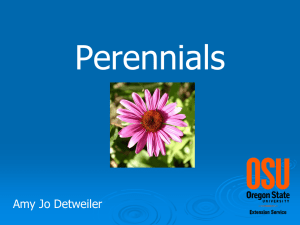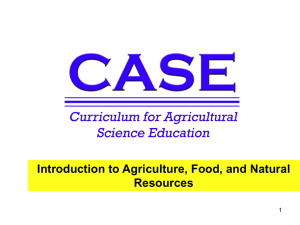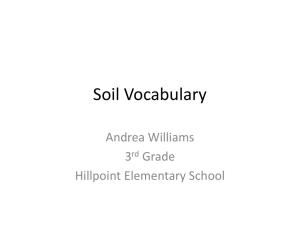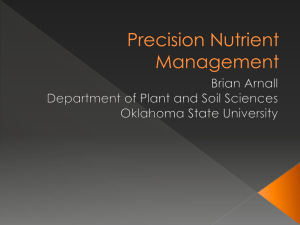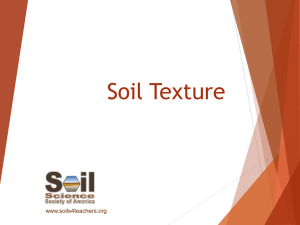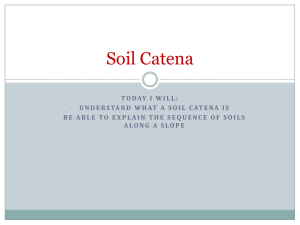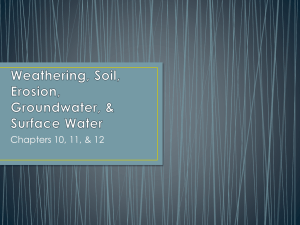Cover Cropping Systems for Organically Farmed Vineyards
advertisement
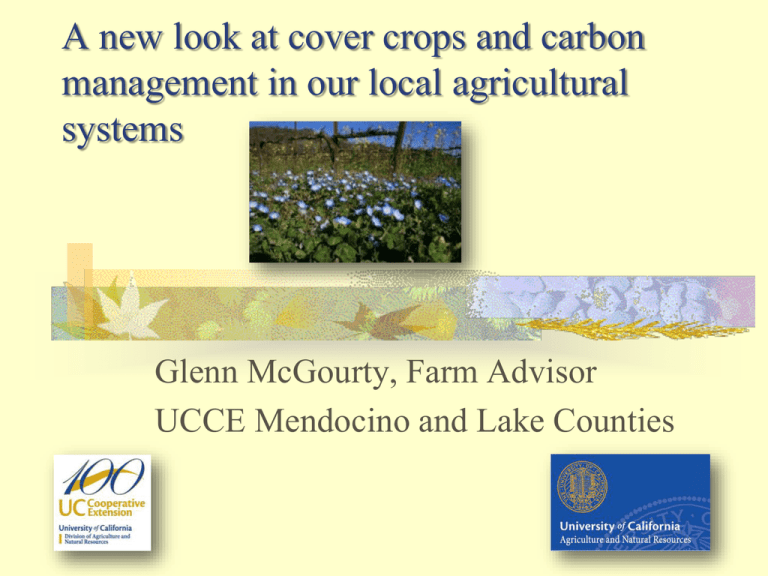
A new look at cover crops and carbon management in our local agricultural systems Glenn McGourty, Farm Advisor UCCE Mendocino and Lake Counties Ecological Services of Your Vineyard and Property Watershed Habitat for native species Pollinators Carbon sequestering and cycling Nutrient cycling Energy cycling through photosynthesis, production of O2 Urban separation and viewshed Vineyard Floor Management Objectives Be cost effective Enhance vine health Increase or decrease vine growth by management practices Improve soil health (bio activity, soil structure, water retention, water infiltration) Firm footing for vineyard operations Control weeds In the beginning… Negative Effects of Tillage: Loss of OM Decreased infiltration of air and water Loss of soil structure Loss of soil biological activity and diversity Carbon Sequestering and Climate Change: Increase of atmospheric CO2 from human activity Loss of carbon from soil by tillage = 30% of total CO2 generated Farming for Carbon Emphasis on managing soils to accumulate stable carbon Focus on natural processes Soil amendments may also be needed Changes in tillage practices Don’t add more CO2 from soil or fossil fuels Possibility of carbon credits? Goals in Improving Soil Chemistry and Fertility with Organic Matter Increase in soil N Improved availability of K, S, and P Improved availability of micronutrients (especially if composts used) Increased soil buffering capacity Increased soil CEC Increase bio activity, both macro and micro Vineyard Organic Matter Per Year, lbs /acre Item Prunings Conventionally Farmed 900 lbs. Organic/ BD . Farmed 900 lbs. Leaves 1200 1200 Weeds/cover c. 1000 1000-10,500 Compost Total, tons/acre 0 1.5 2000 1.5—7.5 t North Coast Soil Issues: Problems: Low pH Low Calcium High Magnesium Low Potassium High clay, poor soil structure Phosphorus deficiency Solutions: Apply Gypsum or Lime “ “ Potassium sulfate Initial ripping, cover crops, reduced tillage Rock phosphorus, compost high in P Soil Structure and Organic Matter Improving Soil Physical Quality You can manage soils to increase SOM Increased SOM often means improved soil structure Change soil structure from blocky to granular Increased soil porosity and lower bulk density with more carbon Improved water holding capacities, infiltration rates Thanks to those you don’t even see… Deep Tillage is Important Initially Rip to rooting depth Don’t destroy soil structure Apply nutrients and amendments that are difficult to leach before ripping Vineyard Floor Management: Tillage Disking Spading Under the vine cultivation Mowing Alternative Cultivation Equipment Cover crops and their effects in vineyards Cover Crops Prevent erosion Attract benefical insects Increase diversity of soil organisms Improve soil structure Retain soil moisture Affect micro-climate Increase organic material and soil fertility Source: A. Thrupp Soil Protection With Cover Crops Cover crop foliage shields soil from rain splashing, slaking of aggregates Water infiltration rates stay elevated Improved water storage, water quality OM conserved by preventing erosion Mulching effect keeps soil cool in summer, protects OM from oxidation Immediate Effects of Cover Crops Plant tissue is the primary source of SOM Soil life is stimulated Cover crops serve as food source for vertebrates, invertebrates and microbes Soil respiration rates and microbe numbers increase SOM Forms Quickest Under Sod Culture Root biomass cycles annually Mulching effects conserve moisture, protect the SOM from sunlight and oxidation Summer Vineyard Floor Management Cover Crop Types Grasses and Legume Mixes Complimentary in growth Good for improving soil structure, tilth May also improve soil fertility Grasses: Fibrous Roots Peas, Vetch, Bell Beans and Oats Cover Crop Fitting the Architecture of the Vineyard vs Self Reseeding Annual Legumes Protect the soil and help water quality Produce N (15-30 lbs/acre) Self Reseeding, no tillage needed Habitat for beneficials Potentially good forage for grazing Works best in higher rainfall areas, or vineyards with sprinklers to help germinate seed Crimson Clover Trifolium resupinatum Subterranean Clover Trifolium subterraneum Bur Medic Medicago polymorpha Balansa Clover Trifolium michelianum Well Mixed Sward Spring Dry Down Seed Production Perennial Cover Crops Can greatly reduce vigor Recommended for fertile sites Grass and legume mixes useful, but not annual and perennial species Grasses: turf-type tall fescue, sheep fescue, creeping red fescue, hard fescue, perennial ryegrass Legumes: white Dutch clover, Ladino clover, strawberry clover—watch out, gopher magnets! Tall Fescue Festuca arundinacea California brome Bromus carinatus What is right for your vineyard or farm? Sprinklers available? What will grow on native rainfall? What will tolerate cold weather and dryness? Insectary Plantings Habitat For Beneficials Shelter Nectar Alternate prey Pollen Can assist your vineyard in creating self-regulation for pest control Dedicated Insectary Rows Parasitoids Predators Wild Carrot or Queen Anne’s Lace Daucus carota Compost and Organic Matter— Helping Your Soil Come Alive Recycled Pomace Manure, lime, gypsum Produced on Farm or Winery Process takes about one year Applied at one or two tons/ acre Nitrogen in Compost r r r r Available N = mineral N in the root zone Mature composts: typically 1 - 3% N= 20 -60 lbs of N Unincorporated materials: Effective applied to cover crops before rains Incorporated materials: may release N or immobilize N in short term Other Minerals in Compost .5-1.0% P (10-20 lbs per ton) .5-3 % K (10-60 lbs per ton) Numerous micronutrients Compost Applications: Beneath vines or across the vineyard floor Vineyard Floor Management: Wooly Mowers Useful Tools for Maintaining Sheep Leaf Pulling by Sheep Aggressive Leaf Pulling by Sheep Helpful Resources Available: UC ANR Press: http://anrcatalog.ucdavis.edu/ Thanks for your attention!

